#Diesel Engine
Explore tagged Tumblr posts
Text
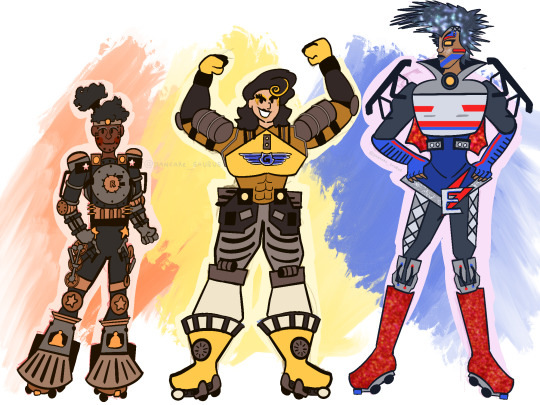
Rusty, Greaseball and Electra except I redesigned them only using the real trains for reference




(All the train photos are from google btw)
#starlight express#stex#trains#rusty the steam engine#stex rusty#rusty stex#rusty starlight express#steam engine#woo woo#greaseball starlight express#stex greaseball#greaseball stex#girlball#greaseball the diesel#diesel engine#electra starlight express#stex electra#electra stex#electra the electric engine#electric engine#engines#i like trains#80s musicals#80s
149 notes
·
View notes
Text
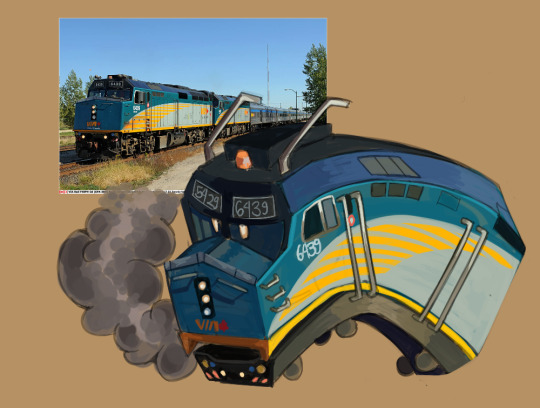
VIA Rail EMD F40PH train dragon
#my art#furry#furry art#dragon#train dragon#train#diesel engine#sketchbook#digital art#procreate#living machine
107 notes
·
View notes
Text
Enginology page 1 (Locomotoridae)






Hopw i can finish the 2nd part, the Curridae family (rolling stock) soon 😭
(AU inspo creds: @steam-beasts <3)
#thomas and friends#au#ttte#thomas the tank engine#thefluffyrailway#monster engines#ttte au#enginology#steam engine#diesel engine#electric engines#ttte edward the blue engine#ttte edward#ttte salty#ttte kenji
50 notes
·
View notes
Text
Happy 80th! (1/4)
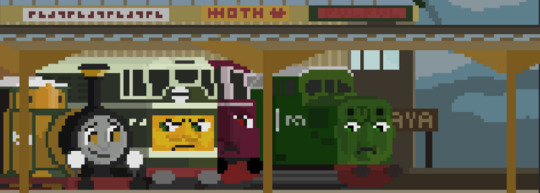
The bluebells are coming
This artwork was featured in the RWS art Collab for this year!
#pixel art#thomas and friends#thomas the tank engine#ttte#ttte fandom#ttte fanart#ttte stepney#diesel engine
25 notes
·
View notes
Text
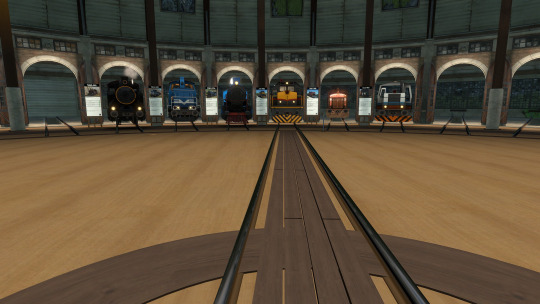
Welcome to the City South Derail Valley Railway Museum. I'm Luna, an engineer with Derail Valley Railworks & Transportation Co. for my day job, and I'll be giving you a tour and I'll explain some of the history of the Museum and its exhibits.
The Museum was originally built in 1970, where it included various historical artifacts of the history of railroading in the Valley, such as a S110-200 Planet-type, the first steam locomotive to work the valley, and the S462-630 Pacific passenger steam loco, and the F060-310 fireless shunter that once worked at the power plant.
In 1973, the Derail Valley Railway donated the Demonstrators to the Railway Museum. These were locomotives sent by the manufacturer for testing on the railway, and when the first batches were sent, the railway kept the good demonstrators and sent away the rest.
Unfortunately during the late days of the Soviet Union, the museum had to be closed, and after the collapse of the Soviet Union, the Demonstrators were sold off to the various company-owned industrial railroads that sprung up on DVRW trackage.
In 2008 the various industrial railroads were conglomerated into the state-owned Derail Valley Railworks & Transportation Company, and the Demonstrators fell into DVRT ownership, but by then many of them had been worked to the bone and abandoned in nearly scrap condition.
Now in 2025, the Derail Valley Railway Museum has been reopened and almost all of the Demonstrators have been restored. Let's take a look at each locomotive in order of its rediscovery.
DH4-670 No.35 Diesel-Hydraulic Road Switcher


The DH4 was the first to be found, as it was discovered on the first meeting of the Museum board of directors as soon as the museum was re-formed--it was directly outside the passenger station in City South, apparently having been set up as a static display when the museum was closed. After moving the DH4 back onto the rails, it was shunted onto the turntable by a battery electric microshunter. Unfortunately the Museum lived up to its name--the turntable was aligned incorrectly.
The DH4-670 wasn't the first DH4 to be trialed by the railway. The west german company MaK designed a similar class for use on Deutsche Bahn, the V90.
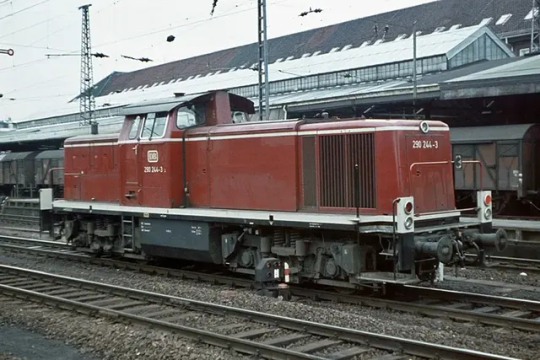
The by-then 10 year old locomotives were trialed in the Valley, but found to be slightly too long for some of the tight curves, so the railway ordered a custom snub-nose variant with shorter hoods and wheelbase, and with a slightly smaller cab. The first of these units to be delivered performed slightly better, so Derail Valley Railway ordered a batch of the locomotives in 1972.


The DH4 Demonstrator was our first restoration project, and served as a testbed and learning experience for many of our volunteers. The DH4 has a day job working for the railway too--we're able to provide entry for free by taking contracts to do deliveries for DVRT using our restored locomotives.
S060-440 No.22 Tank Engine

After the closure of the museum, the S060 demonstrator was sold to the Derail Forest Logging Company, and converted to wood burning, before being abandoned on a siding at the Sawmill.
During World War II, the United States Army Transportation Corps developed several classes of steam locomotives to be exported to assist with the allied war effort, including the S100 class tank engine. After the war, many of these ended up in eastern european countries, such as Yugoslavia and Derail Valley.

Derail Valley classified these as S060-440, while Yugoslavian Railways classified theirs as Class 62. These locomotives became workhorses in shunting yards, and both railways built 'clones' to a very similar design and specification.

The Yugoslavian Class 62s were built from 1952-1961 and can be distinguished by their higher pitched boilers and angled branch pipes connecting to the cylinders.

Popular consensus among the women and men who work on DVRT's steam engines is that the S060-440s are imported Yugoslav Class 62s, but this is a misconception. Derail Valley Railway built their own S100 clones to different specifications.

Note that the side tanks are shorter and more sloped, and the cab windows are much larger, in order to increase visibility and safety.
Though the S060-440 class contains original American S100s, the second batch of Derail native S060s was larger. Thus, the S060 demonstrator has the dubious honor of being younger than some of the other locomotives of its own class which serve in the valley.
The livery the S060 demonstrator was restored into was not that which it was originally built in (it would have been delivered in the same green and black livery as the other S060s), but is instead a passenger livery applied to it by the Derail Valley Railway Museum in 1971 for running excursions to the Harbor and back. Since it became more famous in this livery than the original one, we restored it to this condition as well.
S282-730 No. 83 Mikado Steam Locomotive

The S282 Demonstrator was found on a static display near the disused passenger station in City West in dire condition.
The S282 was originally designated SH282-630, and delivered in the same black livery with red frames that DVRT operates them with to this day. It is a popular misconception that the S282 are USATC S200-class mikados, but these locos are only superficially similar, and at any rate, the S282s were originally built between 1938 and 1945, predating the USATC S200 by 3 years. They were built by the railway's own mechanical department, to an original design, although with some U.S. influences like the cowcatcher-style pilot.
These locomotives served alongside liberated german class 52s (classified as S2X0-740) in the Valley through the 1960s, when many of them were becoming worn out. As diesels (DM3s and DE6s) began to phase out steam in the valley, the railway's chief mechanical officer was unconvinced that dieselization was worth it, given the valley's ample reserves of high-grade coal. (This was before the oil wells were built, so at the time the valley had to import all oil).
In 1978, the CMO brought on steam engineering experts to determine how to uprate the SH282, increasing tonnage and decreasing maintenance costs. The result was the S282-730, which was differentiated from the rest of the fleet by its bright and modern blue livery.
The S282-730 incorporated a larger steam chest, reworked suspension, a superheater, a more advanced exhaust ejector, a larger sand dome, and removed the snifters to reduce steam leaks. (prevention of backdraught was done by leaving the reverser in mid-gear while drifting). A gas producer combustion system firebox was also trialed, which allowed for more complete coal combustion and a much higher steam generation rate in the S282's narrow fireboxes.

The result was a steam locomotive that could rival the DE6 in raw power output, although it had a tendency to wheelslip. The S282s were and still are primarily used on coal trains to the steel mill and power plant, but they often find use on other mixed goods trains when a DE6 is unavailable or uneconomical.
The locomotive was not immediately popular with crews, but the railway management was impressed, and ordered the entire S282 fleet to be converted to the 730 class. The Class 52s were offloaded to other soviet socialist republics and some were scrapped.

No.83 here is the very first of the rebuilt S282s, the experimental one. Though it was eventually repainted in DVRT Black and Red, when it was donated to the museum in 1982 it was restored to its iconic Blue livery.

No.83 double heads a long and heavy freight train alongside a DVRT S282 and DH4 Demonstrator No.35 as a diesel helper. In the future we hope to use the paired blue locomotives on excursion passenger trains, when or if DVRT resumes passenger operations as planned.

Museum locomotives contain several modern amenities to make operations go as smoothly and safely as possible. The throttle and sander is electromechanically controlled by an anti-wheelslip detector like those found in some advanced diesel locomotives, and the engineer side shelf is decked out with electronic amenities such as a roadrunner, clinometer, and switch setter. There's also a digital speedometer on the cab wall and the tender, and LED lights (since the S282s were never built with electric cab lights).
Some of our volunteers think we keep the cab a little too clean, between you and me, but if the rest of the locomotive looks spotless, why not the inside?
DE2-480 No.85 Diesel-Electric Shunter

The DE2 Demonstrator's whereabouts were difficult to track down, until one of our volunteers located it during the routine runs to the Machine Factory & Town to deliver replacement parts for another demonstrator. While servicing the Utility Railbus, the driver noticed it hiding in a pile of scrap next to the Machine Factory's roundhouse. Apparently it had been used as as yard shunter for local industries in the 1990s, before it fell into disrepair and was reallocated as a shop switcher. One day its engine stopped turning over, so it was moved beside the shop and used for spare parts.

The DE2 is one of Derail Valley's original designs, though using imported diesel prime movers, they were built locally in the Machine Factory & Town from 1986 all the way through the fall of the Soviet Union until 1996, to fill the gaps left behind by the aging DM3 and S060 fleet.
By 1996 the economy had tanked enough that exporting locomotives became impossible. Nevertheless, the popularity of the DE2-440 abroad has earned it practically mascot status for Derail Valley, being perhaps the most instantly recognizable locomotive to run on DV metals.
Several DE2s ended up on Czech Railways, which inspired the 708 Series of Diesel Electrics built between 2002 and 2006, which were slightly uprated clones of the Derail-built DE2s. Many of these ended up on Serbian Railways.


This DE2 Demonstrator has the amusing subversion in that it was not a demonstrator sent to the valley, but rather sent by Derail Valley to other countries, hence its incorporation of the iconic orange and blue color scheme found on the DE6. This demonstrator was sent to the United Kingdom, but it was ultimately returned as the UK already had the very successful Class 08 shunters, and then it was given to the Museum, as it was the only locomotive the museum was missing.
DE6-860 No.20 Diesel Electric Road Locomotive

The DE6 Demonstrator was found buried in the bushes in the Goods Factory passenger station, having been used for some of the last passenger trains to run in the valley before it was left on its own and vandalized.
Although it was recovered into museum custody a while ago, it was only recently that the Museum could afford to have it restored, as it is a very expensive and complicated locomotive.
The first DE6 to arrive in the valley was an Electro-Motive Division G16, an export from the U.S.A., built in 1958-1972, similar to those used in other eastern european countries.

The first unit arrived in 1958, and crews found them comfortable and efficient compared to steam engines, although a derailment on the old trackage near City West a few months into its trial led to disappointment--it was just too long. The G16 demonstrator was sent back to EMD, and the Derail Valley Railway ordered a custom-built prototype for a shortened G16 from EMD, using shorter frames but the same diesel prime mover, and the cut-nose short-hood design employed on Australian G16s.

The prototype DE6-860 arrived in 1960, and was even better enjoyed than the G16. Several batches were ordered between 1960 and 1975. Another batch was planned in 1980, but was cancelled due to the success of the S282-730 refit class.

Although in the long run the DE6s ended up being less economical to use than the S282s for most operations due to their much cheaper fuel costs, the DE6 still very much has a place as it can be strung together with other DE6s to form a multiple unit, capable of pulling some of DVRT's longest mixed trains.

The DE6 is the most recent Demonstrator to be restored, the restoration actually having been finished just yesterday. It has yet to be christened with an actual run-in. The Demonstrator, number 20, was the prototype of the DE2-860 class, the very first ever built. It has a few mechanical oddities as a result, but over the years it has been put in-line with the rest of the class. When number 20 was built, it had the high-hood of the original G16, but this was modified by Derail Valley Railway in 1965.
DM3-540 No. 56 Diesel-Mechanical Shunter

Can you spot No.56 in this photograph of the steel mill?
The DM3 Demonstrator has proved to be the most difficult to track down. There was no documentation we could find as to its whereabouts, so the Museum sent out volunteers to all of the stations and industries served by the railway to seek it out, or at least find information about if it had been scrapped or sold.
The research done by our volunteers led to the DM3's resting spot being narrowed down to a few specific possible locations, which were checked individually.
The expedition to the steel mill nearly packed up and left, before someone noticed something red in the bushes.

The DM3 was rerailed and towed away by the Utility Railbus just yesterday, while the finishing touches were being made on the DE6.
We learned from the management that the DM3 demonstrator had been used since 1997 as a yard switcher for the steel mill, occasionally taking trains on the road when no other engine was available. It had actually been in use by the Steel Mill as late as 2014, when it finally died, and since by then DVRT had moved in to handle operations in the steel mill, it was never repaired.
The DM3 was built in East Germany and shares some similarities with the British Railways Class 04 diesels.

This design similarity may be intentional or simply a coincidence, but the actual mechanics of the locomotive are very different, with a prime mover almost twice as large as the Class 04. Sorry Mavis. From uh. Thomas the Tank Engine.
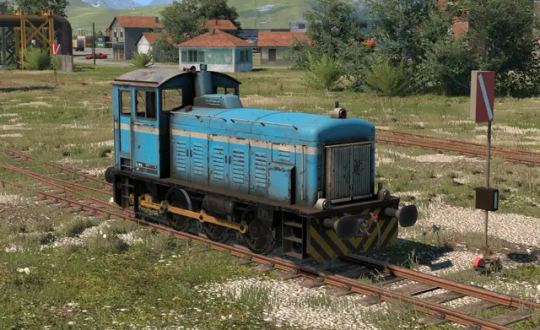
The DM3 was the first successful diesel engine class to work in Derail Valley, having arrived in 1949, with more batches purchased through to 1962. The DM3 has a reputation among railway crews for being able to move a mountain if given enough sand, due to its manual transmission and very low gear ratio. Indeed, despite being smaller, it can often outshunt a DH4, although it is limited to very low speeds and even with a small train they can only go about 60 kph before the engine takes damage.
The DM3 is the most thermally efficient locomotive operated by DVRT, since a diesel engine is one of the most efficient heat engines and a diesel mechanical applies the power of a diesel engine with minimal heat losses. In addition, its relatively simple engine makes it the easiest locomotive to repair and service. We expect the DM3 Demonstrator's restoration to be relatively smooth, and it was in better condition than some of the other demonstrators.
Thank you for visiting the museum, and feel free to look at the Demonstrators and let me or another volunteer know if you have any questions.

#Derail Valley#Derail Valley Railworks & Transportation Company#train#diesel train#diesel engine#diesel locomotive#steam train#steam engine#steam locomotive#locomotive#worldbuilding#headcanon#Derail Valley headcanon#fanfic#Derail Valley Museum#Demonstrator#Derail Valley Demonstrator#Roundhouse
22 notes
·
View notes
Text
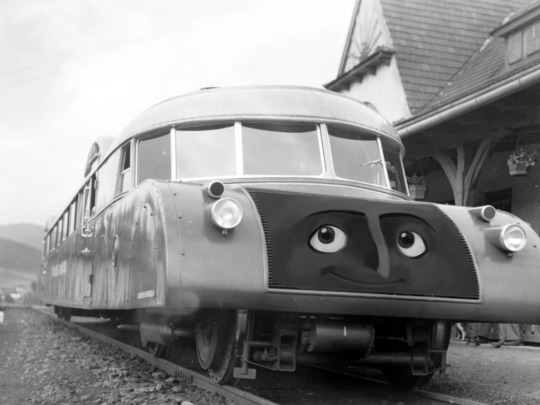
"This? Very old photo, me."
#thomas and friends#thomas the tank engine#ttte#photo edit#photograph edit#ttte oc#thomas and friends oc#thomas the tank engine oc#luxtorpeda#polishcore#polishposting#art edit#fancharacter#railcar oc#diesel engine oc#diesel engine#diesel locomotive#railcar#original character
29 notes
·
View notes
Text
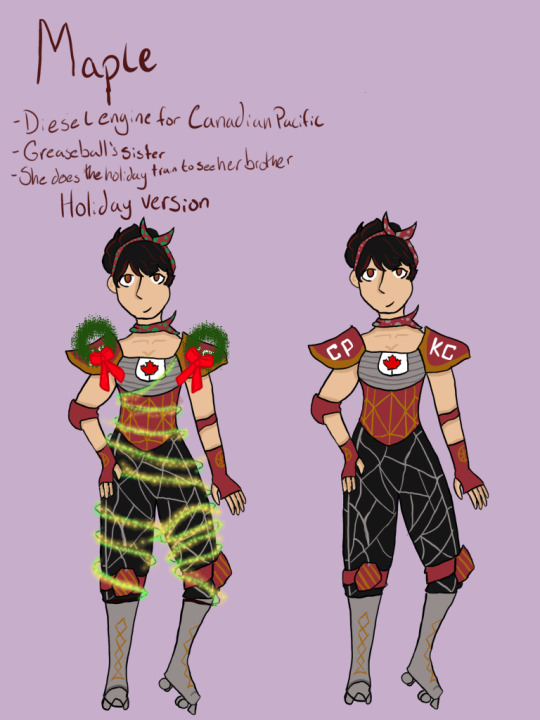
I finished the Canadian pacific train!
Maple is the engine who pulls freight cars and does the Holiday train. She loves the holiday train as she uses it to see her brother Greaseball.
#starlight express#stex greaseball#diesel engine#stex oc#stex#Oc#stex fanart#starlight express fanart
20 notes
·
View notes
Text
she's got that motor running (sound on)
9 notes
·
View notes
Text
One thing I found slightly goofy in Gundam: Iron Blooded Orphans was that despite it being however many centuries in the future, with giant robots, spaceships, colonies on Mars, neo-feudalist warrior clans, all the cities on Earth looked almost exactly the same as they do now.
Did all the buildings survive the robot apocalypse unharmed, and they never built any new ones?
Maybe a Japanese audience wouldn't have noticed with the cities in Alaska and Canada, but I literally live here lmao

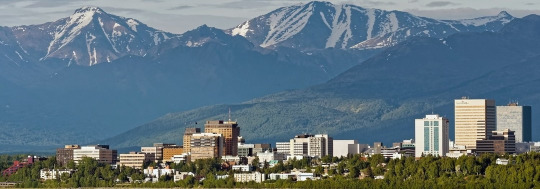
Also, they've got the Schwerer Gustav/Energia-Buran Grasshopper double-rail setup for hauling mobile suits around, but they're still using 20th century diesel locomotives in almost the same Alaska Railroad color scheme.
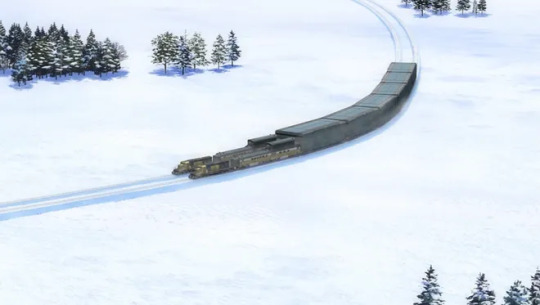

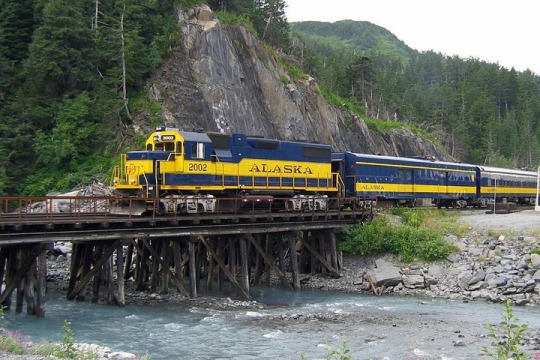
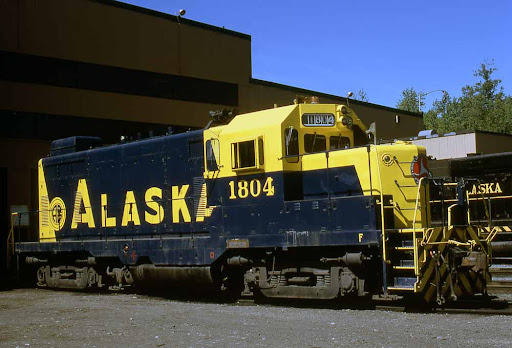
#gundam#mobile suit gundam iron blooded orphans#worldbuilding#aesthetics of the future#suspension of disbelief#alaska#anchorage#canada#edmonton#locomotives#diesel engine#railroads#trains#architecture
36 notes
·
View notes
Text
Hey you! Do you like trains? If you do then ya might consider following my other blog where i post my videos/photos of Croatia's various trains!
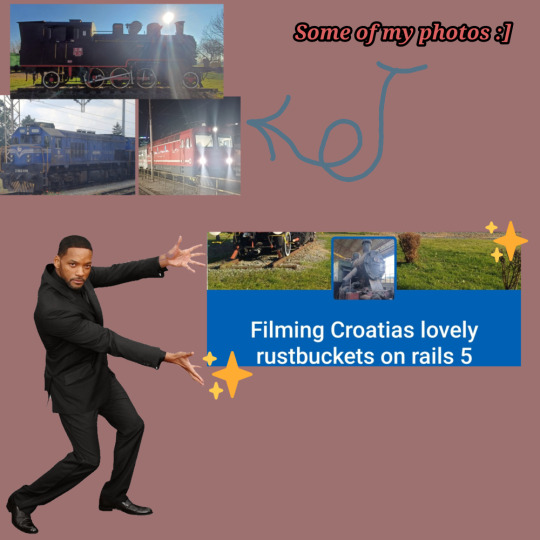
Heres a little HŽ 2044 doodle :]

#art#photography#train drawing#steam locomotive#real railways#railways#railway#ttte#train art#railway art#diesel engine#diesel locomotive#steam engine
14 notes
·
View notes
Text
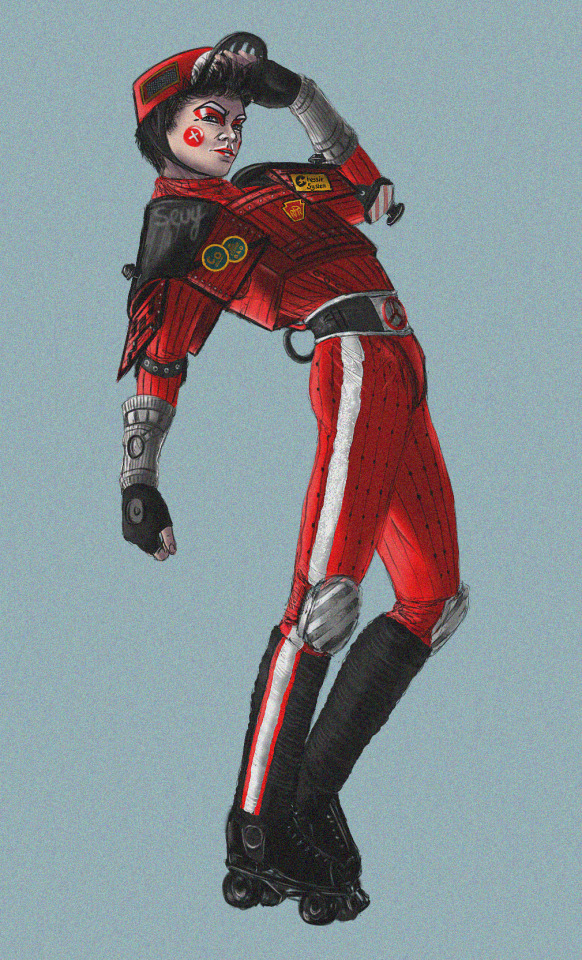
Can I be of help at all? Then simply call C.B!
Please click for better quality
#starlight express#stex#cb the red caboose#cb stex#starlight express caboose#the red caboose#my art#fan art#andrew lloyd webber#musicals#steam engines#caboose#diesel engine#railways
77 notes
·
View notes
Note
Top 5 trains!
I'm bad at knowing actual classes/types but I CAN list some specific ones I've seen or what to see C: in no particular order because I'm notoriously awful at picking faves of literally anything-

GSMR 1702, a 2-8-0 Consolidation type engine that used to run troop transport/training exercises at Fort Bragg, NC. Baldwin built, has a 3 chime whistle that sounds ethereal in the gorge she runs in C: (photo is from my 2024 summer trip!)

SR 6133, an F-unit (iirc) streamlined diesel engine that runs the museum trains at NCTM alongside a few other older diesels, including a high hood diesel and another F-unit! I've just always had a soft spot for this style of rolling stock, I love seeing things that are as appealing as they are functional. And Southern has a kickass livery for these :> (photo from one of my visits to the museum!)

ACL 501, another streamlined diesel that's at NCTM! I just think it's neat lol. And ACL would've been another of my 'local' lines here in NC! The livery is bright and just looks super nice too C: iirc the museum has this engine on loan from either a private collection or the state, so it doesn't run often/if at all, but is kept in running condition. (photo from my most recent museum visit!)

RGS 20, a narrow gauge ten-wheeler currently residing and running the loop at the Colorado Railroad Museum! The story behind me liking this engine is kinda funny actually. A few years ago (2022 or so iirc) I stumbled across a video explaining how steam engines work, which was a collab with someone who works/volunteers for CRRM. Stumbled into that guy's channel, got to see a lot of stuff behind the scenes and learn a lot about the museum's engines, and kinda fell in love with 20 because she's smol but full of personality c: I'm genuinely hoping to get out west one of these days both to see 20 in person and also to visit the Durango and Silverton, GSMR's sister railroad (same company runs them)! (photo- RailPictures.net, Kevin Madore)
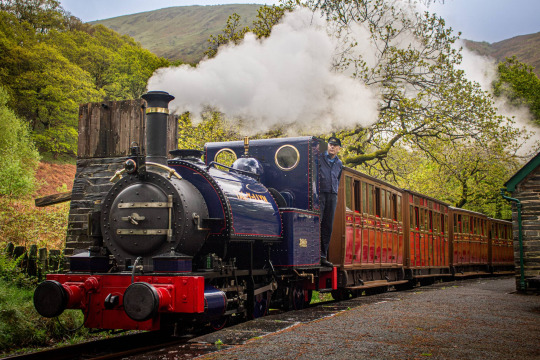
Talyllyn, the famous irl inspiration for the Skarloey Railway in the Railway Series and part of the first heritage railway! c: I absolutely LOVE the smaller gauged railways and different build styles of non-American engines, they're so cute ;w; Talyllyn has had a few different liveries over the years but I'm partial to this blue one and another that's darker red! I really wanna go back to the UK eventually and visit, as a railfan and as someone who grew up with the Railway Series books (and a history buff too)! I'd love to see how the other side of the pond does steam <3 (photo- from the official Talyllyn Railway website)
hehe I rambled a bit buuuuuttt that's what you get for asking me about something that lives rent free in me brain C:<
9 notes
·
View notes
Text
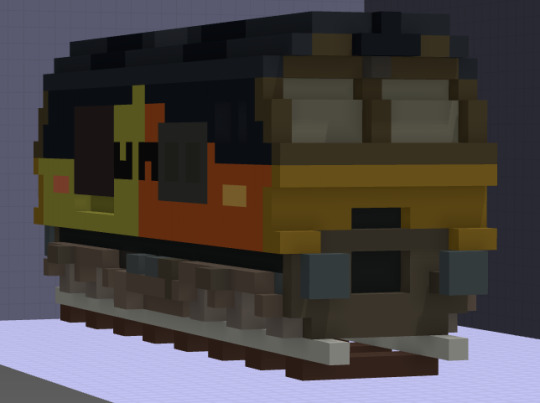
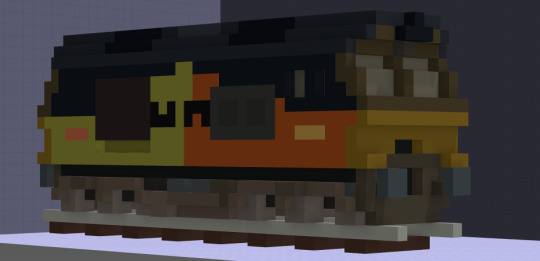
Based off of the amazing @railwaycreature's OC Ross, here's another 3D model! Sadly I couldn't add a face so it's more of a regular Class 66, but alas
#class 66#ttte oc#ttte oc fanart#motharaya#railwaycreature#voxels#train#trains#diesel#diesel train#diesel engine
22 notes
·
View notes
Text
Hm. I'm bored. Can y'all show me your favorite IRL engines? Or you favorite ttte engine. I'm not picky. Feel free to tell me all about them! I wanna hear!
#ttte#Thomas and Friends#thomas the tank engine#steam locomotive#steam engine#diesel engine#Electric engine#railway#train
20 notes
·
View notes
Text

Made a Trainmorph design for Diesel. I gave him a stocky build cause I thought it would suit him but what do y'all think? I wish I made his chest smaller honestly.
27 notes
·
View notes
Text
Did a bit of doodling yesterday, trying to see if I could draw trains (as is not anthropomorphic/humanoid) and I think I did pretty good for having no reference in front of me!

We have a diesel engine and a red caboose(which is coloured because I’m using the drawing over on my CB rp blog tomorrow).
9 notes
·
View notes